
CELEBRITY MASTER CHEF DR KAVIRAJ KHIALANI
Introduction to Indonesian Cuisine
Indonesian cuisine is a vibrant blend of flavors, influenced by Malay, Chinese, Indian, and European cultures. Staples include rice, noodles, and tropical fruits. Dishes like nasi goreng (fried rice) and rendang (beef stew) are popular for their rich, spicy flavors. Street foods like satay and gado-gado offer savory delights, while sweet treats like martabak and es teler satisfy any sweet tooth. Overall, Indonesian cuisine is a diverse and delicious experience for food lovers.
Origin of Indonesian Cuisine
Indonesian cuisine has evolved from the rich culinary traditions of its diverse ethnic groups, including the Malay, Javanese, and Balinese. Influences from traders and colonial powers have also shaped the cuisine, with spices and ingredients from China, India, the Middle East, and Europe adding depth to dishes. Today, Indonesian cuisine is a flavorful blend of indigenous flavors and international influences, making it a unique and delightful culinary experience.
Health Benefits of Indonesian Cuisine
Indonesian cuisine offers several health benefits due to its diverse use of fresh ingredients and aromatic spices. Some of the key health benefits include:
- Rich in Antioxidants: Indonesian dishes often include ingredients like turmeric, ginger, and garlic, which are rich in antioxidants. These compounds help protect the body against cell damage and reduce inflammation.
- High in Fiber: Many Indonesian dishes feature vegetables and legumes, which are high in fiber. Fiber is essential for digestive health and can help lower cholesterol levels.
- Balanced Nutrients: Indonesian meals typically include a variety of food groups, providing a balance of carbohydrates, proteins, and fats. This balanced approach to nutrition supports overall health and well-being.
- Heart-Healthy Ingredients: Ingredients like coconut milk, fish, and spices such as turmeric and ginger are known for their heart-healthy properties. They can help reduce cholesterol levels and lower the risk of heart disease.
- Supports Weight Management: Indonesian cuisine often uses lean proteins and vegetables, which can help support weight management when part of a balanced diet.
- Boosts Immunity: The use of garlic, ginger, and turmeric in Indonesian cooking can help boost the immune system and protect against illnesses.
Overall, Indonesian cuisine offers a range of health benefits due to its emphasis on fresh ingredients, balanced nutrition, and use of traditional spices and herbs.
A few popular Indonesian Recipes to try out in your Kitchens:
NASI GORENG (INDONESIAN FRIED RICE)
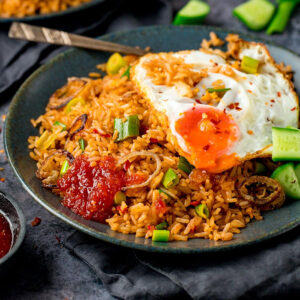
Ingredients
- 2 cups cooked white rice, preferably cold
- 2 tablespoons vegetable oil
- 2 eggs, beaten
- 1 onion, finely chopped
- 2 cloves garlic, minced
- 1 red chili, finely chopped
- 1 tablespoon kecap manis (sweet soy sauce)
- 1 tablespoon soy sauce
- Salt and pepper to taste
- Sliced cucumber and tomato, for garnish
- Fried shallots, for garnish
Method
- Heat vegetable oil in a wok or large pan over medium heat. Add the beaten eggs and scramble until fully cooked. Remove from the pan and set aside.
- In the same pan, add a bit more oil if needed and sauté the onion, garlic, and chili until fragrant.
- Add the cooked rice, kecap manis, soy sauce, salt, and pepper. Stir-fry for a few minutes until well combined and heated through.
- Return the scrambled eggs to the pan and mix well with the rice.
- Serve hot, garnished with sliced cucumber, tomato, and fried shallots.
GADO-GADO (INDONESIAN SALAD WITH PEANUT SAUCE)
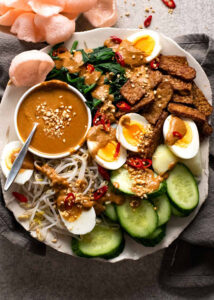
Ingredients
- 2 cups mixed vegetables (such as boiled potatoes, green beans, bean sprouts, and cabbage)
- 1 cucumber, sliced
- 2 hard-boiled eggs, sliced
- Fried tofu and tempeh, sliced
- 1/2 cup peanut sauce (store-bought or homemade)
- Fried shallots, for garnish
Method
- Arrange the mixed vegetables, cucumber slices, sliced eggs, and tofu/tempeh on a plate.
- Drizzle the peanut sauce over the vegetables.
- Sprinkle with fried shallots and serve immediately.
RENDANG (INDONESIAN CHICKEN STEW)
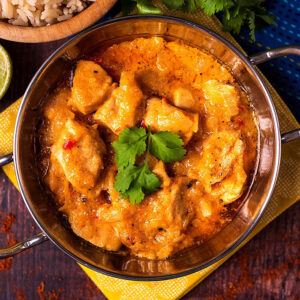
Ingredients
- 500g Chicken, cut into cubes
- 400ml coconut milk
- 1 stalk lemongrass, bruised
- 4 kaffir lime leaves
- 1 turmeric leaf (optional)
- 2 tablespoons tamarind paste
- Salt and sugar to taste
- Spice paste (blend the following):
- 6 shallots
- 4 cloves garlic
- 2 red chilies
- 1 inch ginger
- 1 inch galangal
- 1 teaspoon ground coriander
- 1/2 teaspoon ground cumin
- 1/2 teaspoon ground turmeric
Method
- Heat some oil in a pot and sauté the spice paste until fragrant.
- Add the chicken cubes and cook until browned.
- Add the coconut milk, lemongrass, kaffir lime leaves, turmeric leaf, and tamarind paste. Stir well.
- Season with salt and sugar. Cover and simmer over low heat for 2-3 hours, or until the chicken is tender and the sauce has thickened.
- Serve hot with steamed rice.
SATE AYAM (CHICKEN SATAY)
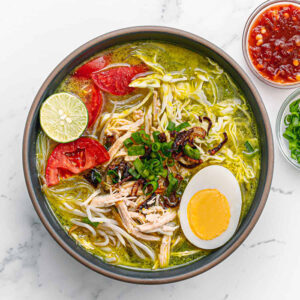
Ingredients
- 500g chicken thigh fillets, cut into cubes
- Bamboo skewers, soaked in water
- 1/2 cup coconut milk
- 2 tablespoons soy sauce
- 1 tablespoon kecap manis (sweet soy sauce)
- 1 tablespoon tamarind paste
- 1 tablespoon brown sugar
- Spice paste (blend the following):
- 4 shallots
- 2 cloves garlic
- 1 teaspoon ground coriander
- 1/2 teaspoon ground cumin
- 1/2 teaspoon turmeric powder
Method
- Combine the spice paste, coconut milk, soy sauce, kecap manis, tamarind paste, and brown sugar in a bowl. Mix well.
- Add the chicken cubes to the marinade and mix until well coated. Marinate for at least 1 hour, preferably overnight.
- Thread the marinated chicken onto bamboo skewers.
- Grill or barbecue the skewers until the chicken is cooked through and slightly charred, basting with the marinade occasionally.
- Serve hot with peanut sauce and rice cakes.
PISANG GORENG (INDONESIAN FRIED BANANAS)

Ingredients
- 4 ripe bananas, peeled and sliced
- 1 cup all-purpose flour
- 1/2 cup rice flour
- 1/4 cup sugar
- 1/2 teaspoon salt
- 1/2 teaspoon baking powder
- 3/4 cup water
- Oil for frying
Method
- Combine the all-purpose flour, rice flour, sugar, salt, and baking powder in a bowl. Gradually add water and mix until smooth.
- Dip the banana slices into the batter, coating them evenly.
- Heat oil in a pan over medium heat. Fry the banana slices until golden brown and crispy.
- Drain on paper towels and serve warm.
SOTO AYAM (INDONESIAN CHICKEN SOUP)
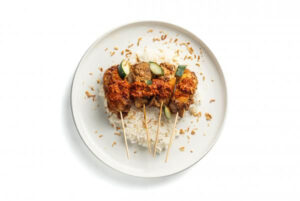
Ingredients
- 500g chicken pieces
- 2 liters water
- 2 lemongrass stalks, bruised
- 4 kaffir lime leaves
- 2 bay leaves
- 200g bean sprouts
- 200g vermicelli noodles, cooked
- 2 hard-boiled eggs, halved
- Fried shallots, for garnish
- Lime wedges, for serving
- Spice paste (blend the following):
- 4 shallots
- 2 cloves garlic
- 1 inch ginger
- 1 teaspoon ground turmeric
- 1 teaspoon ground coriander
- 1/2 teaspoon ground cumin
Method
- In a large pot, bring the water to a boil. Add the chicken pieces, lemongrass, kaffir lime leaves, bay leaves, and spice paste. Reduce heat and simmer until the chicken is cooked through.
- Remove the chicken from the pot and shred the meat. Return the shredded chicken to the pot.
- Add the bean sprouts and cook for another 2-3 minutes.
- To serve, divide the vermicelli noodles and shredded chicken among bowls. Ladle the soup over the top.
- Garnish with hard-boiled eggs, fried shallots, and lime wedges.
Conclusion
In conclusion, Indonesian cuisine is a vibrant and diverse culinary experience, reflecting the country’s rich cultural heritage and diverse influences. From fragrant rice dishes like Nasi Goreng to spicy stews like Rendang, Indonesian food offers a wide range of flavors and textures that appeal to food lovers worldwide. Whether you’re savoring street food delights like Satay or enjoying a traditional meal like Soto Ayam, Indonesian cuisine is sure to delight your taste buds and leave you craving more.
Celebrity Master Chef Dr Kaviraj Khialani is a Mumbai-based hotel-restaurant and food consultant. He is specialised in over 33 international cuisines and has quality experience with hotels and airlines as a part of his long journey of over two decades in his chosen field. Chef Kaviraj is a renowned author, academician, food designer, writer and has also been awarded several national awards and global recognitions for his talent & outstanding achievements. Besides having been featured on several food shows on ColorsTV and Star Plus he is a mentor, coach and guide to aspiring to be future chefs and hoteliers of tomorrow.
He can be contacted at twitter: @kaviraj_chef, Mobile: 91 9820939336. Mail: chefkaviraj249@gmail.com
Also Read:
London Book of World Records fetes Navjeevan Express Food & Hospitality editor Dr Kaviraj Khialani










